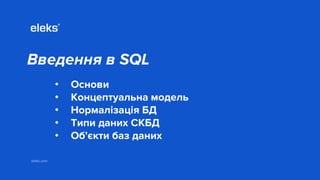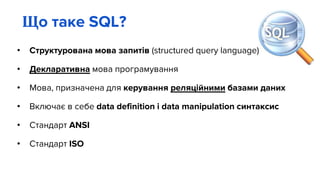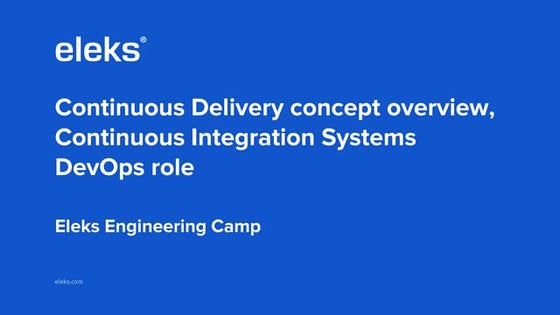sql introduction
- 1. eleks.comeleks.com ąÆą▓ąĄą┤ąĄąĮąĮčÅ ą▓ SQL ŌĆó ą×čüąĮąŠą▓ąĖ ŌĆó ąÜąŠąĮčåąĄą┐čéčāą░ą╗čīąĮą░ ą╝ąŠą┤ąĄą╗čī ŌĆó ąØąŠčĆą╝ą░ą╗č¢ąĘą░čåč¢čÅ ąæąö ŌĆó ąóąĖą┐ąĖ ą┤ą░ąĮąĖčģ ąĪąÜąæąö ŌĆó ą×ą▒'čöą║čéąĖ ą▒ą░ąĘ ą┤ą░ąĮąĖčģ
- 2. ą®ąŠ čéą░ą║ąĄ SQL? ŌĆó ąĪčéčĆčāą║čéčāčĆąŠą▓ą░ąĮą░ ą╝ąŠą▓ą░ ąĘą░ą┐ąĖčéč¢ą▓ (structured query language) ŌĆó ąöąĄą║ą╗ą░čĆą░čéąĖą▓ąĮą░ ą╝ąŠą▓ą░ ą┐čĆąŠą│čĆą░ą╝čāą▓ą░ąĮąĮčÅ ŌĆó ą£ąŠą▓ą░, ą┐čĆąĖąĘąĮą░č湥ąĮą░ ą┤ą╗čÅ ą║ąĄčĆčāą▓ą░ąĮąĮčÅ čĆąĄą╗čÅčåč¢ą╣ąĮąĖą╝ąĖ ą▒ą░ąĘą░ą╝ąĖ ą┤ą░ąĮąĖčģ ŌĆó ąÆą║ą╗čÄčćą░čö ą▓ čüąĄą▒ąĄ data definition č¢ data manipulation čüąĖąĮčéą░ą║čüąĖčü ŌĆó ąĪčéą░ąĮą┤ą░čĆčé ANSI ŌĆó ąĪčéą░ąĮą┤ą░čĆčé ISO
- 3. ą¤čĆąŠ ąĪąÜąæąö CąĖčüč鹥ą╝ą░ ą║ąĄčĆčāą▓ą░ąĮąĮčÅ ą▒ą░ąĘą░ą╝ąĖ ą┤ą░ąĮąĖčģ, ą░ąĮą│ą╗. ┬½DBMS┬╗ ŌĆō čüčāą║čāą┐ąĮč¢čüčéčī ą┐čĆąŠą│čĆą░ą╝ąĮąĖčģ ą┐čĆąŠą┤čāą║čéč¢ą▓, čēąŠ ąĘą░ą▒ąĄąĘą┐ąĄčćčāčÄčéčī ą╝ąŠąČą╗ąĖą▓ąŠčüčéč¢ ą┤ą╗čÅ čüčéą▓ąŠčĆąĄąĮąĮčÅ, ąŠąĮąŠą▓ą╗ąĄąĮąĮčÅ čéą░ ą║ąĄčĆčāą▓ą░ąĮąĮčÅ ą▒ą░ąĘą░ą╝ąĖ ą┤ą░ąĮąĖčģ. ąĪą╗č¢ą┤ čĆąŠąĘčĆč¢ąĘąĮčÅčéąĖ ą▒ą░ąĘčā ą┤ą░ąĮąĖčģ ŌĆö čüčģąŠą▓ąĖčēąĄ ą┤ą░ąĮąĖčģ, čéą░ ąĪąÜąöąæ ŌĆö ąĘą░čüąŠą▒ąĖ ą┤ą╗čÅ čĆąŠą▒ąŠčéąĖ ąĘ ą▒ą░ąĘąŠčÄ ą┤ą░ąĮąĖčģ. ąĪąÜąöąæ ąĘ č¢ąĮč乊čĆą╝ą░čåč¢ą╣ąĮąŠčŚ čüąĖčüč鹥ą╝ąĖ ą╝ąŠąČąĄ ą▒čāčéąĖ ą▓ąĖą┤ą░ą╗ąĄąĮą░, ą░ą╗ąĄ ą▒ą░ąĘą░ ą┤ą░ąĮąĖčģ ą┐čĆąŠą┤ąŠą▓ąČąĖčéčī č¢čüąĮčāą▓ą░čéąĖ. ąå ąĮą░ą▓ą┐ą░ą║ąĖ: ąĪąÜąöąæ ą╝ąŠąČąĄ čäčāąĮą║čåč¢ąŠąĮčāą▓ą░čéąĖ ą▒ąĄąĘ ąČąŠą┤ąĮąŠčŚ ą▒ą░ąĘąĖ ą┤ą░ąĮąĖčģ.
- 5. ąöą╗čÅ č湊ą│ąŠ ą┐ąŠčéčĆč¢ą▒ąĮč¢ ąæą░ąĘąĖ ąöą░ąĮąĖčģ? ŌĆó ą×čĆą│ą░ąĮč¢ąĘąŠą▓ą░ąĮąĄ čéą░ ą║ąŠąĮčüčéčĆčāą║čéąĖą▓ąĮąĄ ąĘą▒ąĄčĆč¢ą│ą░ąĮąĮčÅ ą┤ą░ąĮąĖčģ. ŌĆó ąÜąĄčĆčāą▓ą░ąĮąĮčÅ ą┤ą░ąĮąĖą╝ąĖ čéą░ ą┤ąŠčüčéčāą┐ąŠą╝ ą┤ąŠ ąĮąĖčģ ŌĆó ąĀąŠąĘą┤č¢ą╗ąĄąĮąĮčÅ ąĮą░ą▓ą░ąĮčéą░ąČąĄąĮąĮčÅ ŌĆó ą×ą┤ąĮąĄ ą┤ąČąĄčĆąĄą╗ąŠ ą┐čĆą░ą▓ą┤ąĖ ą║čĆą░čēąĄ, ąĮč¢ąČ ą▒ą░ą│ą░č鹊 ą┤ąČąĄčĆąĄą╗ ąóąĖą┐ąĖ ą▒ą░ąĘ ą┤ą░ąĮąĖčģ: - ąĀąĄą╗čÅčåč¢ą╣ąĮč¢ - ą×ą▒ŌĆÖčöą║čéąĮąŠ-ąŠčĆč¢čöąĮč鹊ą▓ą░ąĮč¢ - ąåčöčĆą░čĆčģč¢čćąĮč¢
- 6. ąÜąŠąĮčåąĄą┐čéčāą░ą╗čīąĮą░ ą╝ąŠą┤ąĄą╗čī ąÜąŠąĮčåąĄą┐čéčāą░ą╗čīąĮą░ ą╝ąŠą┤ąĄą╗čī ąĮą░ą╣ą┐ąŠą▓ąĮč¢čłąĄ ą▓č¢ą┤ą┐ąŠą▓č¢ą┤ą░čö ą┐ąŠčéčĆąĄą▒ą░ą╝ ą┐čĆąŠąĄą║čéčāą▓ą░ąĮąĮčÅ ą▒ą░ąĘąĖ ąĘąĮą░ąĮčī čéą░ ą┐ąŠą▒čāą┤ąŠą▓ą░ąĮą░ ąĮą░ ą┐ąĄą▓ąĮąĖčģ ą┐čĆąĖąĮčåąĖą┐ą░čģ, čüą┐ąĖčĆą░čöčéčīčüčÅ ąĮą░ ą┤ą▓č¢ ąŠą▒ą╗ą░čüčéč¢ ą┐ąŠąĮčÅčéčī ŌĆō ą┤ąĄčĆąĄą▓ąŠ čéąĖą┐č¢ą▓ ą┤ą░ąĮąĖčģ čéą░ ą┤ąĄčĆąĄą▓ąŠ ą┤ą░ąĮąĖčģ. ą×ą▒ŌĆÖčöą║čé ŌĆō čüčāą║čāą┐ąĮč¢čüčéčī čéąĖą┐č¢ą▓ čéą░ ą▓ą╗ą░čüčéąĖą▓ąŠčüč鹥ą╣, ąŠą▒ŌĆÖčöą┤ąĮą░ąĮąĖčģ ą▓ ąŠą┤ąĖąĮ čéąĖą┐ čÅą║ąĖą╣ ą╝ąŠąČąĄ ąŠą┐ąĖčüą░čéąĖ čĆąĄą░ą╗čīąĮąĖą╣ ąŠą▒ŌĆÖčöą║čé ąĀč¢ą▓ąĄąĮčī čüą┐čĆąŠčēąĄąĮąŠčüčéč¢/ą┤ąĄčéą░ą╗č¢ąĘą░čåč¢čŚ ŌĆō čĆč¢ą▓ąĄąĮčī ą┐čĆąĄą┤čüčéą░ą▓ą╗ąĄąĮąĮčÅ čĆąĄą░ą╗čīąĮąŠą│ąŠ ąŠą▒ŌĆÖčöą║čéčā, čÅą║ąĖą╣ ą┤ąŠčüčéą░čéąĮč¢ą╣ ą┐čĆąĖ ą╣ąŠą│ąŠ ąŠą┐ąĖčüč¢ ą▓ čüąĖčüč鹥ą╝č¢ čéą░ ą┐ąŠą┤ą░ą╗čīčłąŠą╝čā ą▓ąĖą║ąŠčĆąĖčüčéą░ąĮąĮč¢. ąÆą╗ą░čüčéąĖą▓č¢čüčéčī ąŠą▒ŌĆÖčöą║čéčā ŌĆō čåąĄ ąŠą┤ąĮą░ č¢ąĘ čģą░čĆą░ą║č鹥čĆąĖčüčéąĖą║ ąŠą▒ŌĆÖčöą║čéčā, č¢ąĮč乊čĆą╝ą░čåč¢čÄ ą┐čĆąŠ čÅą║ąĖą╣ ąĘą▒ąĄčĆč¢ą│ą░čÄčéčī ą▓ ą▒ą░ąĘč¢ ą┤ą░ąĮąĖčģ (ąæąö)
- 7. ą¤ąŠą┤č¢čŚ ŌĆō ąĮą░ą▒č¢čĆ čĆąĄą░ą║čåč¢ą╣ čĆąĄą░ą╗čīąĮąŠą│ąŠ ąŠą▒ŌĆÖčöą║čéčā ąŠą┐ąĖčüą░ąĮąĖčģ ą▓ ąæąö. ąóąĖą┐ ŌĆō ąĮą░ą▒č¢čĆ ą▓ą╗ą░čüčéąĖą▓ąŠčüč鹥ą╣ čéą░ ą┐ąŠą┤č¢ą╣ ąŠą▒ŌĆÖčöą║čéčā, ąŠą┐ąĖčüą░ąĮąĖčģ ą▓ čöą┤ąĖąĮąĖą╣ ą║ąŠą╝ą┐ą╗ąĄą║čü. ą¤čĆąĖ čåčīąŠą╝čā, ą▓ ąĘą░ą╗ąĄąČąĮąŠčüčéč¢ ą▓č¢ą┤ čĆč¢ą▓ąĮčÅ čüą┐čĆąŠčēąĄąĮąŠčüčéč¢, ą▓ą╗ą░čüčéąĖą▓č¢čüčéčÄ čéąĖą┐čā ą╝ąŠąČąĄ ą▒čāčéąĖ č¢ąĮčłąĖą╣ čéąĖą┐. ąŚą▓ŌĆÖčÅąĘąŠą║ ŌĆō čåąĄ ą▓ą╗ą░čüčéąĖą▓č¢čüčéčī čéąĖą┐čā ą░ą▒ąŠ čéąĖą┐ ą▓ą╗ą░čüčéąĖą▓ąŠčüčéč¢, čÅą║ą░ čģą░čĆą░ą║č鹥čĆąĖąĘčāčö ą▓ąĘą░čöą╝ąŠąĘą▓ŌĆÖčÅąĘąŠą║ čéąĖą┐č¢ą▓ čā ą┤ąĄčĆąĄą▓č¢ ą┤ą░ąĮąĖčģ ą░ą▒ąŠ čüą┐ąŠčüč¢ą▒ ąĘą╝č¢ąĮąĖ ąĘąĮą░č湥ąĮąĮčÅ ą▓ą╗ą░čüčéąĖą▓ąŠčüčéč¢ ąŠą▒ŌĆÖčöą║čéąĮąŠą│ąŠ čéąĖą┐čā ą▓č¢ą┤ą┐ąŠą▓č¢ą┤ąĮąŠ. ąæčāą▓ą░čÄčéčī čéčĆąĖ čéąĖą┐ąĖ čéą░ą║ąĖčģ ąĘą▓ŌĆÖčÅąĘą║č¢ą▓: ’āś ąÆą║ą╗čÄč湥ąĮąĮčÅ ą▓ ą┤ąĄčĆąĄą▓ąŠ ą┤ą░ąĮąĖčģ; ’āś ąÆčüčéą░ą▓ą║ą░ ąĘ ąŠą┤ąĮąŠą│ąŠ čéąĖą┐čā ąĘąĮą░č湥ąĮąĮčÅ ą▓ą╗ą░čüčéąĖą▓ąŠčüč鹥ą╣ čéąĖą┐čā; ’āś ą¤ąŠčüąĖą╗ą░ąĮąĮčÅ ąĮą░ ąĄą║ąĘąĄą╝ą┐ą╗čÅčĆ čéąĖą┐čā ą▓ ą┤ąĄčĆąĄą▓č¢ ą┤ą░ąĮąĖčģ. ąÜąŠąĮčåąĄą┐čéčāą░ą╗čīąĮą░ ą╝ąŠą┤ąĄą╗čī
- 8. ąÜąŠąĮčåąĄą┐čéčāą░ą╗čīąĮą░ ą╝ąŠą┤ąĄą╗čī ąØą░ą╣ą╝ąĄąĮčłą░ ąŠą┤ąĖąĮąĖčåčÅ ą┤ą░ąĮąĖčģ čĆąĄą╗čÅčåč¢ą╣ąĮąŠčŚ ą╝ąŠą┤ąĄą╗č¢ ŌĆō čåąĄ ąŠą║čĆąĄą╝ąĄ ą░č鹊ą╝ą░čĆąĮąĄ (ąĮąĄčĆąŠąĘą║ą╗ą░ą┤ąĮąĄ) ą┤ą╗čÅ ą┤ą░ąĮąŠčŚ ą╝ąŠą┤ąĄą╗č¢ ąĘąĮą░č湥ąĮąĮčÅ ą┤ą░ąĮąĖčģ. ąöąŠą╝ąĄąĮąŠą╝ ąĮą░ąĘąĖą▓ą░čöčéčīčüčÅ ą╝ąĮąŠąČąĖąĮą░ ą░č鹊ą╝ą░čĆąĮąĖčģ ąĘąĮą░č湥ąĮąĖą╣ ąŠą┤ąĮąŠą│ąŠ č¢ č鹊ą│ąŠ ąČąĄ čéąĖą┐čā. ąŚą░ą│ąŠą╗ąŠą▓ąŠą║ ą┤ąŠą╝ąĄąĮčā ŌĆō čåąĄ ąĮą░ą▒č¢čĆ ą░čéčĆąĖą▒čāčéč¢ą▓, čēąŠ ą▓čģąŠą┤čÅčéčī ą▓ ą┤ąŠą╝ąĄąĮ, ą░ čéč¢ą╗ąŠ ą┤ąŠą╝ąĄąĮčā čüą║ą╗ą░ą┤ą░čöčéčīčüčÅ č¢ąĘ ą╝ąĮąŠąČąĖąĮąĖ ąĘąĮą░č湥ąĮčī, čēąŠ ą▓č¢ą┤ą┐ąŠą▓č¢ą┤ą░čÄčéčī čåąĖą╝ ą░čéčĆąĖą▒čāčéą░ą╝. ąÜąŠąČąĄąĮ čéą░ą║ąĖą╣ ąĮą░ą▒č¢čĆ ąĘąĮą░č湥ąĮčī ąĮą░ąĘąĖą▓ą░čÄčéčī ą║ąŠčĆč鹥ąČąĄą╝. ąĪč鹥ą┐č¢ąĮčī ą▓č¢ą┤ąĮąŠčłąĄąĮąĮčÅ ŌĆō čåąĄ čćąĖčüą╗ąŠ ą░čéčĆąĖą▒čāčéč¢ą▓ ą┤ąŠą╝ąĄąĮčā. ąÆč¢ą┤ąĮąŠčłąĄąĮąĮčÅ čüč鹥ą┐ąĄąĮč¢ ąŠą┤ąĖąĮ ąĮą░ąĘąĖą▓ą░čÄčéčī čāąĮą░čĆąĮąĖą╝, čüč鹥ą┐ąĄąĮč¢ ą┤ą▓ą░ ŌĆō ą▒č¢ąĮą░čĆąĮąĖą╝, čüč鹥ą┐ąĄąĮč¢ čéčĆąĖ ŌĆō č鹥čĆąĮą░čĆąĮąĖą╝, ..., ą░ čüč鹥ą┐ąĄąĮč¢ n ŌĆō n-ą░čĆąĮąĖą╝. ąÜą░čĆą┤ąĖąĮą░ą╗čīąĮąĄ čćąĖčüą╗ąŠ ą░ą▒ąŠ ą┐ąŠčéčāąČąĮč¢čüčéčī ą▓č¢ą┤ąĮąŠčłąĄąĮąĮčÅ ŌĆō čåąĄ čćąĖčüą╗ąŠ ą╣ąŠą│ąŠ ą║ąŠčĆč鹥ąČč¢ą▓. ąÜą░čĆą┤ąĖąĮą░ą╗čīąĮąĄ čćąĖčüą╗ąŠ ą▓č¢ą┤ąĮąŠčłąĄąĮąĮčÅ ąĘą╝č¢ąĮčÄčöčéčīčüčÅ ą▓ čćą░čüč¢, ąĮą░ ą▓č¢ą┤ą╝č¢ąĮčā ą▓č¢ą┤ ą╣ąŠą│ąŠ čüč鹥ą┐ąĄąĮč¢.
- 9. ŌĆó ąøąŠą│č¢čćąĮą░ ą╝ąŠą┤ąĄą╗čī ą┤ą░ąĮąĖčģ, ąĘą░ą┐čĆąŠą┐ąŠąĮąŠą▓ą░ąĮą░ čüą┐č¢ą▓čĆąŠą▒č¢čéąĮąĖą║ąŠą╝ IBM ąĢ.ąż.ąÜąŠą┤ąŠą╝ ą▓ 1970 čĆąŠčåč¢ ŌĆó ąæč¢ą╗čīčł ą▓ąĖčüąŠą║ąĖą╣ čĆč¢ą▓ąĄąĮčī ą░ą▒čüčéčĆą░ą║čåč¢čŚ, ąĮč¢ąČ ą▓ ą╝ąĄčĆąĄąČąĄą▓č¢ą╣ čćąĖ č¢čöčĆą░čĆčģč¢čćąĮč¢ą╣ ą╝ąŠą┤ąĄą╗čÅčģ ŌĆó ąĪą┐ąŠčüč¢ą▒ ąŠą┐ąĖčüčā ą┤ą░ąĮąĖčģ čéą░ ąĘą▓ŌĆÖčÅąĘą║č¢ą▓ ą╝č¢ąČ ąĮąĖą╝ąĖ ŌĆó ąŚą▓ąĖčćą░ą╣ąĮą░ ŌĆ£čĆąĄą╗čÅčåč¢ą╣ąĮą░ ą╝ąŠą┤ąĄą╗čīŌĆØ ŌĆō čåąĄ čćąĖčüčéą░ ą╝ą░č鹥ą╝ą░čéąĖą║ą░, čēąŠ ą▒ą░ąĘčāčöčéčīčüčÅ ąĮą░ čĆąĄą╗čÅčåč¢ą╣ąĮč¢ą╣ ą░ą╗ą│ąĄą▒čĆč¢ ŌĆó SQL ą▓ąĖą║ąŠčĆąĖčüč鹊ą▓čāčö ┬½ą┐ąŠą║čĆą░čēąĄąĮčā┬╗, ┬½čĆąŠąĘčłąĖčĆąĄąĮčā┬╗ čĆąĄą╗čÅčåč¢ą╣ąĮčā ą╝ąŠą┤ąĄą╗čī, ą░ą╗ąĄ ą╝ąĖ ą▓čüąĄ čēąĄ ą▓ąĖą║ąŠčĆąĖčüč鹊ą▓čāčöą╝ čåąĄą╣ č鹥čĆą╝č¢ąĮ ą┤ą╗čÅ ąŠą┐ąĖčüčā čĆąŠą▒ąŠčéąĖ čüąĖčüč鹥ą╝ąĖ ąĀąĄą╗čÅčåč¢ą╣ąĮą░ ą╝ąŠą┤ąĄą╗čī
- 10. ąĀąĄą╗čÅčåč¢ą╣ąĮą░ ą╝ąŠą┤ąĄą╗čī ą▓ ąæąö
- 11. ą£ąŠą┤ąĄą╗čī ą┤ą░ąĮąĖčģ ŌĆ×čüčāčéąĮč¢čüčéčī-ąĘą▓ŌĆÖčÅąĘąŠą║ŌĆØ (entity - relationship model, ER - model) ąĮą░ą╣ą▒č¢ą╗čīčł ą▒ą╗ąĖąĘčīą║ą░ ą┤ąŠ ą║ąŠąĮčåąĄą┐čéčāą░ą╗čīąĮąŠčŚ ą╝ąŠą┤ąĄą╗č¢, čģąŠčćą░ ą╣ ą▒č¢ą╗čīčł ąŠą▒ą╝ąĄąČąĄąĮą░ ąĘ č鹊čćą║ąĖ ąĘąŠčĆčā ą║ąŠčĆąĖčüčéčāą▓ą░čćą░. ąĀąŠąĘą│ą╗čÅąĮąĄą╝ąŠ ąŠčüąĮąŠą▓ąĮč¢ ą║ąŠąĮčüčéčĆčāą║čéąĖą▓ąĮč¢ ąĄą╗ąĄą╝ąĄąĮčéąĖ čéą░ą║ąŠčŚ ą╝ąŠą┤ąĄą╗č¢ ą┤ą░ąĮąĖčģ: ’āś ąĪčāčéąĮč¢čüčéčī ŌĆō ą▒čāą┤čī-čÅą║ąĖą╣ ąŠą▒ŌĆÖčöą║čé, čÅą║ąĖą╣ ą╝ąŠąČąĮą░ ą▓č¢ą┤čĆč¢ąĘąĮąĖčéąĖ ą▓č¢ą┤ č¢ąĮčłąŠą│ąŠ. ą»ą║ č¢ ą▓ ą║ąŠąĮčåąĄą┐čéčāą░ą╗čīąĮč¢ą╣ ą╝ąŠą┤ąĄą╗č¢, čüčāčéąĮč¢čüčéčī ą╝ą░čö čéąĖą┐ čéą░ ą╣ąŠą│ąŠ ąĄą║ąĘąĄą╝ą┐ą╗čÅčĆ. ’āś ąÉčéčĆąĖą▒čāčé ŌĆō ą┐ąŠč¢ą╝ąĄąĮąŠą▓ą░ąĮą░ čģą░čĆą░ą║č鹥čĆąĖčüčéąĖą║ą░ čüčāčéąĮąŠčüčéč¢. ąÉčéčĆąĖą▒čāčéąĖ ą▓ąĖą║ąŠčĆąĖčüč鹊ą▓čāčÄčéčīčüčÅ ą┤ą╗čÅ ą▓ąĖąĘąĮą░č湥ąĮąĮčÅ č¢ąĮč乊čĆą╝ą░čåč¢čŚ, čÅą║čā ąĮąĄąŠą▒čģč¢ą┤ąĮąŠ ąĘč¢ą▒čĆą░čéąĖ ą┐čĆąŠ čüčāčéąĮč¢čüčéčī. ąæčāą┤čī-čÅą║ąĖą╣ ą░čéčĆąĖą▒čāčé ą╝ąŠąČąĄ ą▒čāčéąĖ čüčāčéąĮč¢čüčéčÄ, ą▓ ąĘą░ą╗ąĄąČąĮąŠčüčéč¢ ą▓č¢ą┤ č鹊čćą║ąĖ ąĘąŠčĆčā ąĮą░ ąĮčīąŠą│ąŠ. ą£ąŠą┤ąĄą╗čī ┬½čüčāčéąĮč¢čüčéčī-ąĘą▓ŌĆÖčÅąĘąŠą║┬╗
- 12. ąŚą▓ŌĆÖčÅąĘąŠą║ ŌĆō ą░čüąŠčåč¢ą░čåč¢čÅ ą┤ą▓ąŠčģ ą░ą▒ąŠ ą▒č¢ą╗čīčłąĄ čüčāčéąĮąŠčüč鹥ą╣. ąŚą▓ŌĆÖčÅąĘąŠą║ ŌĆ׹׹öąśąØ ąöą× ą×ąöąØą×ąōą×ŌĆØ: ą▓ ą║ąŠąČąĄąĮ ą╝ąŠą╝ąĄąĮčé ą┐čĆąĄą┤čüčéą░ą▓ąĮąĖą║čā čüčāčéąĮąŠčüčéč¢ ąÉ ą▓č¢ą┤ą┐ąŠą▓č¢ą┤ą░čö ąŠą┤ąĖąĮ ą░ą▒ąŠ ąČąŠą┤ąĄąĮ ą┐čĆąĄą┤čüčéą░ą▓ąĮąĖą║ čüčāčéąĮąŠčüčéč¢ ąÆ. ą”ąĄ ą╝ąŠąČąĮą░ ąŠą┐ąĖčüą░čéąĖ čÅą║ ąĮą░čüą╗č¢ą┤čāą▓ą░ąĮąĮčÅ ąŠą┤ąĮąŠčŚ čüčāčéąĮąŠčüčéč¢ ą▓č¢ą┤ č¢ąĮčłąŠčŚ. ąŚą▓ŌĆÖčÅąĘąŠą║ ŌĆ׹׹öąśąØ ąöą× ąæąÉąōąÉąóą¼ą×ąźŌĆØ: ą▓ ą▒čāą┤čī-čÅą║ąĖą╣ čćą░čü ąŠą┤ąĮąŠą╝čā ąĄą║ąĘąĄą╝ą┐ą╗čÅčĆčā čüčāčéąĮąŠčüčéč¢ ąÉ ą▓č¢ą┤ą┐ąŠą▓č¢ą┤ą░čö ąŠą┤ąĖąĮ, ą┤ą▓ą░ čéą░ ą▒č¢ą╗čīčłąĄ ą┐čĆąĄą┤čüčéą░ą▓ąĮąĖą║č¢ą▓ čüčāčéąĮąŠčüčéč¢ ąÆ ą░ą▒ąŠ ąĮąĄ ą▓č¢ą┤ą┐ąŠą▓č¢ą┤ą░čö ąČąŠą┤ąĮąŠą│ąŠ ąĘ ąĮąĖčģ. ąÆ ą║ąŠąĮčåąĄą┐čéčāą░ą╗čīąĮč¢ą╣ ą╝ąŠą┤ąĄą╗č¢ čéą░ą║ąŠą╝čā ą▓ą░čĆč¢ą░ąĮčéčā ą▓č¢ą┤ą┐ąŠą▓č¢ą┤ą░čö ą▓ą║ą╗čÄč湥ąĮąĮčÅ. ąŚą▓ŌĆÖčÅąĘą║ąĖ A AB B 1 1 A AB B 1 1 B 1 B 1
- 13. ąÜą╗čÄčćč¢ ąÜą╗čÄčć ŌĆō ą╝č¢ąĮč¢ą╝ą░ą╗čīąĮąĖą╣ ąĮą░ą▒č¢čĆ ą░čéčĆąĖą▒čāčéč¢ą▓, ą┐ąŠ ąĘąĮą░č湥ąĮąĮčÅą╝ čÅą║ąĖčģ ą╝ąŠąČąĮą░ ąŠą┤ąĮąŠąĘąĮą░čćąĮąŠ ąĘąĮą░ą╣čéąĖ ą┐ąŠčéčĆč¢ą▒ąĮąĖą╣ ąĄą║ąĘąĄą╝ą┐ą╗čÅčĆ čüčāčéąĮąŠčüčéč¢. ą»ą║ ą┐čĆą░ą▓ąĖą╗ąŠ ŌĆō čåąĄ ą┐ąĄčĆą▓ąĖąĮąĮąĖą╣ ą║ą╗čÄčć ą▓ čéą░ą▒ą╗ąĖčåč¢ ąæąö, ą┐čĆąŠč鹥 ą▒č¢ą╗čīčł čåč¢ą║ą░ą▓ąĖą╝ąĖ ąĮą░ ą┤ą░ąĮąŠą╝čā ąĄčéą░ą┐č¢ čö ąĘąŠą▓ąĮč¢čłąĮč¢ ą║ą╗čÄčćč¢: ’āś ą»ą║čēąŠ čüčāčéąĮč¢čüčéčī ąĪ ąĘą▓ŌĆÖčÅąĘčāčö čüčāčéąĮąŠčüčéč¢ ąÉ čéą░ ąÆ, č鹊 ą▓ąŠąĮą░ ą┐ąŠą▓ąĖąĮąĮą░ ą▓ą║ą╗čÄčćą░čéąĖ ąĘąŠą▓ąĮč¢čłąĮč¢ ą║ą╗čÄčćč¢, čÅą║č¢ ą▓č¢ą┤ą┐ąŠą▓č¢ą┤ą░čÄčéčī ą┐ąĄčĆą▓ąĖąĮąĮąĖą╝ ą║ą╗čÄčćą░ą╝ čüčāčéąĮąŠčüč鹥ą╣ ąÉ čéą░ ąÆ. ’āś ą»ą║čēąŠ čüčāčéąĮč¢čüčéčī ąÆ ą▓ąĖąĘąĮą░čćą░čö čüčāčéąĮč¢čüčéčī ąÉ, č鹊 ą▓ąŠąĮą░ ą┐ąŠą▓ąĖąĮąĮą░ ą▓ą║ą╗čÄčćą░čéąĖ ąĘąŠą▓ąĮč¢čłąĮč¢ą╣ ą║ą╗čÄčć, čÅą║ąĖą╣ ą▓č¢ą┤ą┐ąŠą▓č¢ą┤ą░čö ą┐ąĄčĆą▓ąĖąĮąĮąŠą╝čā ą║ą╗čÄčćčā čüčāčéąĮąŠčüčéč¢ ąÉ. ą»ą║čēąŠ ą║ąŠčĆč鹥ąČč¢ č¢ą┤ąĄąĮčéąĖčäč¢ą║čāčÄčéčīčüčÅ čéč¢ą╗čīą║ąĖ ąĘč湥ą┐ą╗ąĄąĮąĮčÅą╝ ąĘąĮą░č湥ąĮčī ą┤ąĄą║č¢ą╗čīą║ąŠčģ ą░čéčĆąĖą▒čāčéč¢ą▓, č鹊 ą│ąŠą▓ąŠčĆčÅčéčī, čēąŠ ą▓č¢ą┤ąĮąŠčłąĄąĮąĮčÅ ą╝ą░čö čüą║ą╗ą░ą┤ąĄąĮąĖą╣ ą║ą╗čÄčć. ą¤čĆąĄą┤čüčéą░ą▓ą╗ąĄąĮąĮčÅ ą╝ąŠąČąĄ ą╝č¢čüčéąĖčéąĖ ą║č¢ą╗čīą║ą░ ą║ą╗čÄčćč¢ą▓.
- 14. ąØąŠčĆą╝ą░ą╗č¢ąĘą░čåč¢čÅ ąæąö ąØąŠčĆą╝ą░ą╗čīąĮą░ č乊čĆą╝ą░ - čåąĄ čéą░ą║ą░ č乊čĆą╝ą░ č湊ą│ąŠ-ąĮąĄą▒čāą┤čī, čēąŠ ąĮąĄ ą┤ąŠą┐čāčüą║ą░čö ą┐ąŠą┤ą░ą╗čīčłąĖčģ čüą┐čĆąŠčēąĄąĮčī. ąöą╗čÅ ąæąö ąĮąŠčĆą╝ą░ą╗čīąĮą░ č乊čĆą╝ą░ ŌĆö ą▓ą╗ą░čüčéąĖą▓č¢čüčéčī ą▓č¢ą┤ąĮąŠčłąĄąĮąĮčÅ ą▓ čĆąĄą╗čÅčåč¢ą╣ąĮąŠčŚ ą╝ąŠą┤ąĄą╗č¢ ą┤ą░ąĮąĖčģ, čēąŠ čģą░čĆą░ą║č鹥čĆąĖąĘčāčö ą╣ąŠą│ąŠ ąĘ č鹊čćą║ąĖ ąĘąŠčĆčā ąĮą░ą┤ą╝č¢čĆąĮąŠčüčéč¢, čÅą║ą░ ą┐ąŠč鹥ąĮčåč¢ą╣ąĮąŠ ą╝ąŠąČąĄ ą┐čĆąĖąĘą▓ąĄčüčéąĖ ą┤ąŠ ą╗ąŠą│č¢čćąĮąŠ ą┐ąŠą╝ąĖą╗ą║ąŠą▓ąĖčģ čĆąĄąĘčāą╗čīčéą░čéč¢ą▓ ą▓ąĖą▒č¢čĆą║ąĖ ą░ą▒ąŠ ąĘą╝č¢ąĮąĖ ą┤ą░ąĮąĖčģ. ąØąŠčĆą╝ą░ą╗č¢ąĘą░čåč¢čÅ čüčģąĄą╝ąĖ ą▒ą░ąĘąĖ ą┤ą░ąĮąĖčģ ŌĆö čåąĄ ą┐ąŠą║čĆąŠą║ąŠą▓ąĖą╣ ą┐čĆąŠčåąĄčü čĆąŠąĘą▒ąĖčéčéčÅ čéą░ą▒ą╗ąĖčåč¢ ąĮą░ ą┤ą▓č¢ ą░ą▒ąŠ ą▒č¢ą╗čīčłąĄ čéą░ą▒ą╗ąĖčåčī, čÅą║č¢ ą╝ą░čÄčéčī ą║čĆą░čēč¢ ą▓ą╗ą░čüčéąĖą▓ąŠčüčéč¢ ą┐čĆąĖ ą▓ą║ą╗čÄč湥ąĮąĮč¢, ąĘą╝č¢ąĮč¢ čéą░ ą▓ąĖą┤ą░ą╗ąĄąĮč¢ ą┤ą░ąĮąĖčģ. ąÜč¢ąĮčåąĄą▓ą░ čåč¢ą╗čī ąĮąŠčĆą╝ą░ą╗č¢ąĘą░čåč¢čŚ ŌĆō ąŠčéčĆąĖą╝ą░ąĮąĮčÅ čéą░ą║ąŠą│ąŠ ą┐čĆąŠąĄą║čéčā ąæąö, ą▓ čÅą║ąŠą╝čā ą║ąŠąČąĮąĖą╣ čäą░ą║čé ą┐ąŠčÅą▓ą╗čÅčöčéčīčüčÅ ą╗ąĖčłąĄ ą▓ ąŠą┤ąĮąŠą╝čā ą╝č¢čüčåč¢, č鹊ą▒č鹊 ą▓ąĖą║ą╗čÄč湥ąĮąĖą╣ ąĮą░ą┤ą╗ąĖčłąŠą║ č¢ąĮč乊čĆą╝ą░čåč¢čŚ.
- 15. ąØąŠčĆą╝ą░ą╗č¢ąĘą░čåč¢čÅ ąæąö ążčāąĮą║čåč¢ąŠąĮą░ą╗čīąĮą░ ąĘą░ą╗ąĄąČąĮč¢čüčéčī: ą¤ąŠą╗ąĄ ąÆ čéą░ą▒ą╗ąĖčåč¢ čäčāąĮą║čåč¢ąŠąĮą░ą╗čīąĮąŠ ąĘą░ą╗ąĄąČąĖčéčī ą▓č¢ą┤ ą┐ąŠą╗čÅ ąÉ čåč¢čöčŚ ąČ čéą░ą▒ą╗ąĖčåč¢ č鹊ą┤č¢ č¢ čéč¢ą╗čīą║ąĖ č鹊ą┤č¢, čÅą║čēąŠ ą▓ ą▒čāą┤čī-čÅą║ąĖą╣ ąĘą░ą┤ą░ąĮąĖą╣ ą╝ąŠą╝ąĄąĮčé čćą░čüčā ą┤ą╗čÅ ą║ąŠąČąĮąŠą│ąŠ ąĘ čĆč¢ąĘąĮąĖčģ ąĘąĮą░č湥ąĮčī ą┐ąŠą╗čÅ ąÉ ąŠą▒ąŠą▓ŌĆÖčÅąĘą║ąŠą▓ąŠ č¢čüąĮčāčö čéč¢ą╗čīą║ąĖ ąŠą┤ąĮąŠ č¢ąĘ čĆč¢ąĘąĮąĖčģ ąĘąĮą░č湥ąĮčī ą┐ąŠą╗čÅ ąÆ. ąŚą░ąĘąĮą░čćąĖą╝ąŠ, čēąŠ ą┤ąŠą┐čāčüą║ą░čÄčéčīčüčÅ čüą║ą╗ą░ą┤ąĄąĮąĮč¢ ą┐ąŠą╗čÅ ąÉ ąĖ ąÆ. ą¤ąŠą▓ąĮą░ čäčāąĮą║čåč¢ąŠąĮą░ą╗čīąĮą░ ąĘą░ą╗ąĄąČąĮč¢čüčéčī: ą¤ąŠą╗ąĄ ąÆ ąĘąĮą░čģąŠą┤ąĖčéčīčüčÅ ą▓ ą┐ąŠą▓ąĮč¢ą╣ čäčāąĮą║čåč¢ąŠąĮą░ą╗čīąĮč¢ą╣ ąĘą░ą╗ąĄąČąĮąŠčüčéč¢ ą▓č¢ą┤ čüą║ą╗ą░ą┤ąĄąĮąŠą│ąŠ ą┐ąŠą╗čÅ ąÉ, čÅą║čēąŠ ą▓ąŠąĮąŠ čäčāąĮą║čåč¢ąŠąĮą░ą╗čīąĮąŠ ąĘą░ą╗ąĄąČąĖčéčī ą▓č¢ą┤ ąÉ č¢ ąĮąĄ ąĘą░ą╗ąĄąČąĖčéčī čäčāąĮą║čåč¢ąŠąĮą░ą╗čīąĮąŠ ą▓č¢ą┤ ą▒čāą┤čī- čÅą║ąŠčŚ ą┐č¢ą┤ą╝ąĮąŠąČąĖąĮąĖ ą┐ąŠą╗čÅ ąÉ. ą£ąĮąŠą│ąŠąĘąĮą░čćąĮą░ ąĘą░ą╗ąĄąČąĮč¢čüčéčī: ą¤ąŠą╗ąĄ ąÉ ą▒ą░ą│ą░č鹊ąĘąĮą░čćąĮąŠ ą▓ąĖąĘąĮą░čćą░čö ą┐ąŠą╗ąĄ ąÆ čåč¢čöčŚ ąČ čéą░ą▒ą╗ąĖčåč¢, čÅą║čēąŠ ą┤ą╗čÅ ą║ąŠąČąĮąŠą│ąŠ ąĘąĮą░č湥ąĮąĮčÅ ą┐ąŠą╗čÅ ąÉ č¢čüąĮčāčö ą▓ąĖąĘąĮą░č湥ąĮą░ ą╝ąĮąŠąČąĖąĮą░ ą▓č¢ą┤ą┐ąŠą▓č¢ą┤ąĮąĖčģ ąĘąĮą░č湥ąĮčī ąÆ.
- 16. ąØąŠčĆą╝ą░ą╗čīąĮč¢ č乊čĆą╝ąĖ 1ąØąż 2ąØąż 3ąØąż ąØążąæąÜ 4ąØąż 5ąØąż ąØąĄąĮąŠčĆą╝ą░ą╗č¢ąĘąŠą▓ą░ąĮč¢ č乊čĆą╝ąĖ
- 18. ąØą░ąĘą▓ą░ ą¤čĆąĖąĘąĮą░č湥ąĮąĮčÅ ą░čéčĆąĖą▒čāčéčā ąóąĖą┐ DocumentNumber ąØąŠą╝ąĄčĆ ą┤ąŠą║čāą╝ąĄąĮčéčā varchar DocumentDate ąöą░čéą░ ą┤ąŠą║čāą╝ąĄąĮčéčā date ClientName ąØą░ąĘą▓ą░ ą┐č¢ą┤ą┐čĆąĖčöą╝čüčéą▓ą░-ą┐ą░čĆčéąĮąĄčĆą░ varchar ClientAddress ąÉą┤čĆąĄčüą░ ą┐č¢ą┤ą┐čĆąĖčöą╝čüčéą▓ą░-ą┐ą░čĆčéąĮąĄčĆą░ varchar ProductName ąØą░ąĘą▓ą░ ą┐čĆąŠą┤čāą║čåč¢čŚ/č鹊ą▓ą░čĆčā varchar BarCode ąÉčĆčéąĖą║čāą╗ ą┐čĆąŠą┤čāą║čåč¢čŚ/č鹊ą▓ą░čĆčā varchar ProductPrice ą”č¢ąĮą░ ąĘą░ ąŠą┤ąĖąĮąĖčåčÄ ą┐čĆąŠą┤čāą║čåč¢čŚ/č鹊ą▓ą░čĆčā money ProductAmount ąÜč¢ą╗čīą║č¢čüčéčī ą┐čĆąŠą┤čāą║čåč¢čŚ/č鹊ą▓ą░čĆčā int ProductSum ąĪčāą╝ą░ ą┐čĆąŠą┤čāą║čåč¢čŚ/č鹊ą▓ą░čĆčā money Comment ąÜąŠą╝ąĄąĮčéą░čĆč¢ ą┤ąŠ ą┤ąŠą║čāą╝ąĄąĮčéčā varchar ą¤ąŠčéčĆč¢ą▒ąĮąŠ ą┐čĆąĄą┤čüčéą░ą▓ąĖčéąĖ ą▓ ąæąö čéą░ą║ąĖą╣ ąĮą░ą▒č¢čĆ ą▓ą╗ą░čüčéąĖą▓ąŠčüč鹥ą╣ ą┤ąŠą║čāą╝ąĄąĮčéčā:
- 19. ąØąŠčĆą╝ą░ą╗č¢ąĘąŠą▓ą░ąĮąĄ ą┐čĆąĄą┤čüčéą░ą▓ą╗ąĄąĮąĮčÅ ą┤ą░ąĮąĖčģ čĆąŠąĘą║ąĖą┤ą░ąĮąĄ ą┐ąŠ ą║č¢ą╗čīą║ąŠčģ čéą░ą▒ą╗ąĖčåčÅčģ: ąØą░ąĘą▓ą░ ą¤čĆąĖąĘąĮą░č湥ąĮąĮčÅ ą░čéčĆąĖą▒čāčéčā ąóąĖą┐ DocumentID ąÜąŠą┤ ą┤ąŠą║čāą╝ąĄąĮčéčā int DocumentNumber ąØąŠą╝ąĄčĆ ą┤ąŠą║čāą╝ąĄąĮčéčā varchar DocumentDate ąöą░čéą░ ą┤ąŠą║čāą╝ąĄąĮčéčā date TypeID ąÜąŠą┤ čéąĖą┐čā ą┤ąŠą║čāą╝ąĄąĮčéčā int ClientID ąÜąŠą┤ ą┐č¢ą┤ą┐čĆąĖčöą╝čüčéą▓ą░-ą┐ą░čĆčéąĮąĄčĆą░ int ProductSum ąĪčāą╝ą░ ą┐čĆąŠą┤čāą║čåč¢čŚ/č鹊ą▓ą░čĆčā money Comment ąÜąŠą╝ąĄąĮčéą░čĆč¢ ą┤ąŠ ą┤ąŠą║čāą╝ąĄąĮčéčā varchar ąØą░ąĘą▓ą░ ą¤čĆąĖąĘąĮą░č湥ąĮąĮčÅ ą░čéčĆąĖą▒čāčéčā ąóąĖą┐ DocumentID ąÜąŠą┤ ą┤ąŠą║čāą╝ąĄąĮčéčā int ProductID ąÜąŠą┤ ą┐čĆąŠą┤čāą║čåč¢čŚ/č鹊ą▓ą░čĆčā int ProductAmount ąÜč¢ą╗čīą║č¢čüčéčī ą┐čĆąŠą┤čāą║čåč¢čŚ/č鹊ą▓ą░čĆčā int ąØą░ąĘą▓ą░ ą¤čĆąĖąĘąĮą░č湥ąĮąĮčÅ ą░čéčĆąĖą▒čāčéčā ąóąĖą┐ TypeID ąÜąŠą┤ čéąĖą┐čā ą┤ąŠą║čāą╝ąĄąĮčéčā int TypeName ąØą░ąĘą▓ą░ čéąĖą┐čā ą┤ąŠą║čāą╝ąĄąĮčéčā varchar TypeComment ąÜąŠą╝ąĄąĮčéą░čĆč¢ ą┤ąŠ čéąĖą┐čā ą┤ąŠą║čāą╝ąĄąĮčéčā varchar ąØą░ąĘą▓ą░ ą¤čĆąĖąĘąĮą░č湥ąĮąĮčÅ ą░čéčĆąĖą▒čāčéčā ąóąĖą┐ ClientID ąÜąŠą┤ ą┐č¢ą┤ą┐čĆąĖčöą╝čüčéą▓ą░-ą┐ą░čĆčéąĮąĄčĆą░ int ClientName ąØą░ąĘą▓ą░ ą┐č¢ą┤ą┐čĆąĖčöą╝čüčéą▓ą░-ą┐ą░čĆčéąĮąĄčĆą░ varchar ClientAddress ąÉą┤čĆąĄčüą░ ą┐č¢ą┤ą┐čĆąĖčöą╝čüčéą▓ą░-ą┐ą░čĆčéąĮąĄčĆą░ varchar ClientComment ąÜąŠą╝ąĄąĮčéą░čĆč¢ ą┤ąŠ ą┤ąŠą║čāą╝ąĄąĮčéčā varchar ąØą░ąĘą▓ą░ ą¤čĆąĖąĘąĮą░č湥ąĮąĮčÅ ą░čéčĆąĖą▒čāčéčā ąóąĖą┐ ProductID ąÜąŠą┤ ą┐čĆąŠą┤čāą║čåč¢čŚ/č鹊ą▓ą░čĆčā int ProductName ąØą░ąĘą▓ą░ ą┐čĆąŠą┤čāą║čåč¢čŚ/č鹊ą▓ą░čĆčā varchar ProductBarCode ąÉčĆčéąĖą║čāą╗ ą┐čĆąŠą┤čāą║čåč¢čŚ/č鹊ą▓ą░čĆčā varchar ProductPrice ą”č¢ąĮą░ ąĘą░ ąŠą┤ąĖąĮąĖčåčÄ ą┐čĆąŠą┤čāą║čåč¢čŚ/č鹊ą▓ą░čĆčā money ProductComment ąÜąŠą╝ąĄąĮčéą░čĆč¢ ą┤ąŠ ą┤ąŠą║čāą╝ąĄąĮčéčā varchar
- 21. ąóąĖą┐ąĖ ą┤ą░ąĮąĖčģ. ą¦ąĖčüą╗ąŠą▓č¢ ąóąĖą┐ ąöč¢ą░ą┐ą░ąĘąŠąĮ ąĘąĮą░č湥ąĮčī ąĀąŠąĘą╝č¢čĆ ą”č¢ą╗ąŠčćąĖčüąĄą╗čīąĮč¢ bigint ą▓č¢ą┤ -263 ą┤ąŠ 263 - 1 8 int ą▓č¢ą┤ -231 ą┤ąŠ 231 - 1 4 smallint ą▓č¢ą┤ -215 ą┤ąŠ 215 - 1 2 tinyint ą▓č¢ą┤ 0 ą┤ąŠ 255 1 bit 0 ą░ą▒ąŠ 1 1 ąŚ ą┤čĆąŠą▒ąŠą▓ąŠčÄ čćą░čüčéąĖąĮąŠčÄ decimal (p,s) / numeric 1038 + 1 ą┤ąŠ 1038 - 1 5-17 money -922,337,203,685,477.5808 to 922,337,203,685,477.5807 8 smallmoney - 214,748.3648 to 214,748.3647 4 float (n) -1.79E + 308 ą┤ąŠ 1.79E + 308 4-8 real (float(24)) -3.40E + 38 ą┤ąŠ -3.40E + 38 4
- 22. ąóąĖą┐ąĖ ą┤ą░ąĮąĖčģ. ąöą░čéąĖ čéą░ čćą░čüčā ąóąĖą┐ ążąŠčĆą╝ą░čé ąŚąĮą░č湥ąĮąĮčÅ ąĀąŠąĘą╝č¢čĆ datetime YYYY-MM-DD hh:mm:ss[. nnn] ą▓č¢ą┤ -263 ą┤ąŠ 263 - 1 8 smalldatetime YYYY-MM-DD hh:mm:ss ą▓č¢ą┤ -231 ą┤ąŠ 231 - 1 4 date YYYY-MM-DD ą▓č¢ą┤ -215 ą┤ąŠ 215 - 1 3 time hh:mm:ss[. nnnnnnn] ą▓č¢ą┤ 0 ą┤ąŠ 255 3-5 datetime2 YYYY-MM-DD hh:mm:ss[. nnnnnnn] 0 ą░ą▒ąŠ 1 6-8 datetimeoffset YYYY-MM-DD hh:mm:ss[. nnnnnnn] [+|-]hh:mm 1038 + 1 ą┤ąŠ 1038 - 1 8-10
- 23. ąóąĖą┐ąĖ ą┤ą░ąĮąĖčģ. ąĪąĖą╝ą▓ąŠą╗čīąĮč¢ čéą░ ą▒č¢ąĮą░čĆąĮč¢ ąóąĖą┐ ąöč¢ą░ą┐ą░ąĘąŠąĮ ąĀąŠąĘą╝č¢čĆ char(n) / nchar(n) 1 Ōēż n Ōēż 4,000 n varchar(n) / nvarchar(n) 1 Ōēż n Ōēż 4,000 <n varchar(max) / nvarchar(max) 1 Ōēż n Ōēż 231-1 <n text / ntext * 231-1 <2n binary(n) 1 Ōēż n Ōēż 8,000 n + 2 varbinary(n) 1 Ōēż n Ōēż 8,000 <n + 2 varbinary(max) 1 Ōēż n Ōēż 231-1 <n image 231-1 <n
- 24. ąóąĖą┐ąĖ ą┤ą░ąĮąĖčģ. ąåąĮčłč¢ ąóąĖą┐ ą×ą┐ąĖčü cursor, table ąĪą┐ąĄčåč¢ą░ą╗čīąĮč¢ čéąĖą┐ąĖ T-SQL timestamp ~ varbinary(8)/ rowversion uniqueidentifier GUID xml ~ nvarchar(max) hierarchyid ~ nvarchar(4000) sql_variant ąĘą▒ąĄčĆč¢ą│ą░čö ąĘąĮą░č湥ąĮąĮčÅ čĆč¢ąĘąĮąĖčģ čéąĖą┐č¢ą▓ ą┤ą░ąĮąĖčģ, ą┐č¢ą┤čéčĆąĖą╝čāą▓ą░ąĮąĖčģ SQL čüąĄčĆą▓ąĄčĆąŠą╝ geometry ą┐čĆąĄą┤čüčéą░ą▓ą╗čÅčö ą┤ą░ąĮč¢ ą▓ ąĄą▓ą║ą╗č¢ą┤ąŠą▓ąŠą╝čā ą┐čĆąŠčüč鹊čĆč¢ geography ą┐čĆąĄą┤čüčéą░ą▓ą╗čÅčö ą┤ą░ąĮč¢ ą▓ čüąĖčüč鹥ą╝č¢ ą║ąŠąŠčĆą┤ąĖąĮą░čé ąŚąĄą╝ą╗č¢
- 25. ą×čüąĮąŠą▓ąĮč¢ čćą░čüčéąĖąĮąĖ SQL ’āś Data Definition Language (DDL) ’é¦ CREATE ’é¦ DROP ’é¦ ALTER ’é¦ TRUNCATE ’āś Data Manipulation Language (DML) ’é¦ SELECT ’é¦ INSERT ’é¦ UPDATE ’é¦ DELETE ’āś Data Control Language (DCL) ’é¦ GRANT ’é¦ REVOKE ’āś Transaction controls ’é¦ BEGIN TRANSACTION ’é¦ COMMIT ’é¦ ROLLBACK
- 26. ą×ą▒ŌĆÖčöą║čé ┬½ąæą░ąĘą░ ą┤ą░ąĮąĖčģ┬╗ ąóąĖą┐ąĖ : Online transaction processing (OLTP) čéą░ Online Analytical Processing (OLAP) ąĪčéą▓ąŠčĆąĄąĮąĮčÅ ąæąö ŌĆō ą▓ąĖą║ąŠčĆąĖčüčéą░ąĮąĮčÅ model database, ąŠčüąŠą▒ą╗ąĖą▓ąŠčüčéč¢ collate ąĪą║čĆč¢ą┐čéąĖ čéą░ č¢ąĮčłč¢ ą▓ą░čĆč¢ą░ąĮčéąĖ ą┐ąĄčĆąĄąĮąĄčüąĄąĮąĮčÅ ąæąö: CREATE DATABASE [TEST] ON PRIMARY (NAME = N'TEST', FILENAME = N'D:MSSQLTestTEST.mdf', SIZE = 4096, MAXSIZE = UNLIMITED, FILEGROWTH = 1024KB) LOG ON (NAME = N'TEST_log', FILENAME = N'D:MSSQLTestTEST_log.ldf', SIZE = 1024KB , MAXSIZE = 2048GB , FILEGROWTH = 10%) COLLATE Latin1_General_CI_AS ąŚą╝č¢ąĮą░ ą┐ą░čĆą░ą╝ąĄčéčĆč¢ą▓ ąæąö: ALTER DATABASE [TEST] SET ANSI_NULLS OFF
- 27. ą×ą▒ŌĆÖčöą║čé ┬½ąóą░ą▒ą╗ąĖčåčÅ┬╗ ąĪčéą▓ąŠčĆąĄąĮąĮčÅ čéą░ą▒ą╗ąĖčåč¢: CREATE TABLE [dbo].[tProducts]( [pInstance] [int] IDENTITY(1,1) NOT NULL, [pName] [varchar](50) NOT NULL, [pBarCode] [nchar](10) NULL, [pPrice] [money] NOT NULL DEFAULT 0, [pNumber] [int] NOT NULL DEFAULT 0, [pComment] [varchar](250) NULL, CONSTRAINT [PK_tProducts] PRIMARY KEY ([pInstance]), CONSTRAINT [UK_tProducts] UNIQUE ([pName])) ON [PRIMARY] ąŚąĮą░č湥ąĮąĮčÅ ąĘą░ ąŠąĘąĮą░č湥ąĮąĮčÅą╝ (DEFAULT)
- 28. ąåąĮčłč¢ ą▓ą╗ą░čüčéąĖą▓ąŠčüčéč¢ čéą░ą▒ą╗ąĖčåčī čéą░ ą║ąŠą╗ąŠąĮąŠą║ ą×ą▒ą╝ąĄąČąĄąĮąĮčÅ (CONSRAINT) ŌĆó NOT NULL ŌĆó CHECK ŌĆó UNIQUE / PRIMARY KEY ŌĆó FOREIGN KEY (NO ACTION, CASCADE, SET NULL, SET DEFAULT) ąÉą▓č鹊 ą│ąĄąĮąĄčĆą░čåč¢čÅ ąĘąĮą░č湥ąĮąĮčÅ (IDENTITY) ą¤čĆą░ą▓ąĖą╗ą░ (CHECK) ąåąĮčłč¢ ą▓ą╗ą░čüčéąĖą▓ąŠčüčéč¢ (FILESTREAM, ROWGUIDCOL, COLLATE, SPARSE,ŌĆ”) ALTER TABLE [dbo].[tDocDetails] WITH CHECK ADD CONSTRAINT [FK_tDocDetails_tProducts] FOREIGN KEY([sProduct]) REFERENCES [dbo].[tProducts] ([pInstance])
- 29. ąĀąĄą║ąŠą╝ąĄąĮą┤ąŠą▓ą░ąĮą░ ą╗č¢č鹥čĆą░čéčāčĆą░ 1. C.J.Date ŌĆ£An introduction to database systemsŌĆØ 2. A.Beaulieu ŌĆ£Learning SQLŌĆØ 3. MSDN
- 30. ą¤ąĖčéą░ąĮąĮčÅ čéą░ ą▓č¢ą┤ą┐ąŠą▓č¢ą┤č¢ ąóčĆčāčēą░ą║ ąåą│ąŠčĆ (TrIgeR@Eleks.com)





















![ąóąĖą┐ąĖ ą┤ą░ąĮąĖčģ. ąöą░čéąĖ čéą░ čćą░čüčā
ąóąĖą┐ ążąŠčĆą╝ą░čé ąŚąĮą░č湥ąĮąĮčÅ ąĀąŠąĘą╝č¢čĆ
datetime YYYY-MM-DD hh:mm:ss[. nnn] ą▓č¢ą┤ -263 ą┤ąŠ 263 - 1 8
smalldatetime YYYY-MM-DD hh:mm:ss ą▓č¢ą┤ -231 ą┤ąŠ 231 - 1 4
date YYYY-MM-DD ą▓č¢ą┤ -215 ą┤ąŠ 215 - 1 3
time hh:mm:ss[. nnnnnnn] ą▓č¢ą┤ 0 ą┤ąŠ 255 3-5
datetime2 YYYY-MM-DD hh:mm:ss[. nnnnnnn] 0 ą░ą▒ąŠ 1 6-8
datetimeoffset
YYYY-MM-DD hh:mm:ss[. nnnnnnn]
[+|-]hh:mm
1038 + 1 ą┤ąŠ 1038 - 1 8-10](https://image.slidesharecdn.com/sql01edited-160418071735/85/sql-introduction-22-320.jpg)



![ą×ą▒ŌĆÖčöą║čé ┬½ąæą░ąĘą░ ą┤ą░ąĮąĖčģ┬╗
ąóąĖą┐ąĖ : Online transaction processing (OLTP) čéą░
Online Analytical Processing (OLAP)
ąĪčéą▓ąŠčĆąĄąĮąĮčÅ ąæąö ŌĆō ą▓ąĖą║ąŠčĆąĖčüčéą░ąĮąĮčÅ model database, ąŠčüąŠą▒ą╗ąĖą▓ąŠčüčéč¢ collate
ąĪą║čĆč¢ą┐čéąĖ čéą░ č¢ąĮčłč¢ ą▓ą░čĆč¢ą░ąĮčéąĖ ą┐ąĄčĆąĄąĮąĄčüąĄąĮąĮčÅ ąæąö:
CREATE DATABASE [TEST] ON PRIMARY
(NAME = N'TEST',
FILENAME = N'D:MSSQLTestTEST.mdf', SIZE = 4096, MAXSIZE = UNLIMITED, FILEGROWTH = 1024KB)
LOG ON (NAME = N'TEST_log',
FILENAME = N'D:MSSQLTestTEST_log.ldf', SIZE = 1024KB , MAXSIZE = 2048GB , FILEGROWTH = 10%)
COLLATE Latin1_General_CI_AS
ąŚą╝č¢ąĮą░ ą┐ą░čĆą░ą╝ąĄčéčĆč¢ą▓ ąæąö:
ALTER DATABASE [TEST] SET ANSI_NULLS OFF](https://image.slidesharecdn.com/sql01edited-160418071735/85/sql-introduction-26-320.jpg)
![ą×ą▒ŌĆÖčöą║čé ┬½ąóą░ą▒ą╗ąĖčåčÅ┬╗
ąĪčéą▓ąŠčĆąĄąĮąĮčÅ čéą░ą▒ą╗ąĖčåč¢:
CREATE TABLE [dbo].[tProducts](
[pInstance] [int] IDENTITY(1,1) NOT NULL,
[pName] [varchar](50) NOT NULL,
[pBarCode] [nchar](10) NULL,
[pPrice] [money] NOT NULL DEFAULT 0,
[pNumber] [int] NOT NULL DEFAULT 0,
[pComment] [varchar](250) NULL,
CONSTRAINT [PK_tProducts] PRIMARY KEY ([pInstance]),
CONSTRAINT [UK_tProducts] UNIQUE ([pName])) ON [PRIMARY]
ąŚąĮą░č湥ąĮąĮčÅ ąĘą░ ąŠąĘąĮą░č湥ąĮąĮčÅą╝ (DEFAULT)](https://image.slidesharecdn.com/sql01edited-160418071735/85/sql-introduction-27-320.jpg)
![ąåąĮčłč¢ ą▓ą╗ą░čüčéąĖą▓ąŠčüčéč¢ čéą░ą▒ą╗ąĖčåčī čéą░ ą║ąŠą╗ąŠąĮąŠą║
ą×ą▒ą╝ąĄąČąĄąĮąĮčÅ (CONSRAINT)
ŌĆó NOT NULL
ŌĆó CHECK
ŌĆó UNIQUE / PRIMARY KEY
ŌĆó FOREIGN KEY (NO ACTION, CASCADE, SET NULL, SET DEFAULT)
ąÉą▓č鹊 ą│ąĄąĮąĄčĆą░čåč¢čÅ ąĘąĮą░č湥ąĮąĮčÅ (IDENTITY)
ą¤čĆą░ą▓ąĖą╗ą░ (CHECK)
ąåąĮčłč¢ ą▓ą╗ą░čüčéąĖą▓ąŠčüčéč¢ (FILESTREAM, ROWGUIDCOL, COLLATE, SPARSE,ŌĆ”)
ALTER TABLE [dbo].[tDocDetails] WITH CHECK
ADD CONSTRAINT [FK_tDocDetails_tProducts] FOREIGN KEY([sProduct])
REFERENCES [dbo].[tProducts] ([pInstance])](https://image.slidesharecdn.com/sql01edited-160418071735/85/sql-introduction-28-320.jpg)








































































